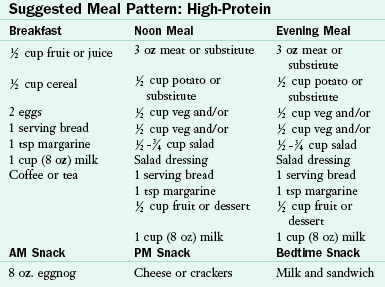Nutritional Facts on a High-Protein Diet
The high-protein diet is designed for individuals requiring increased protein in addition to their normal diet. This diet provides additional high-quality protein, primarily from milk, eggs, cheese, soy, and meat sources. An individual’s protein intake may be increased to 100 g of protein per day, or 1.25 up to 2 g/kg. Indications for use are the presence of pressure ulcers, surgery, infection, or malnutrition. Contraindications include hepatic coma and renal insufficiency. Patients on this diet may have loss of or poor appetite; therefore six feedings per day may improve patient adherence.
Adequacy: The high-protein diet is adequate in all nutrients and exceeds the dietary reference intake for protein.
Minimum Portions to Achieve 100 g of Protein
2-3 Cups or more (8 oz each) fortified milk or substitute
3-4 Servings (2-3 oz servings) meat or meat substitute
3-4 Servings fruits and vegetables (1 vitamin C–rich source daily such as 1 citrus fruit, 1 carotenoid source such as 1 dark green or yellow vegetable)
3-4 Servings or more of whole grain or enriched breads and cereals
Special Notes
1. Nonfat dry milk may be added to cooked foods to increase protein intake. One quarter cup powdered milk is equivalent to 1 cup fluid milk. Nonfat dry milk can be added to hot cereal, cream soups, and casseroles.
2. Supplemental high-protein feedings may be required if the patient has a poor appetite.
3. One fluid cup (8 oz) commercial eggnog contains 15 g of protein, almost twice as much protein as 1 fluid cup (8 oz) of milk. This is a very good snack for use in a high-protein diet.
